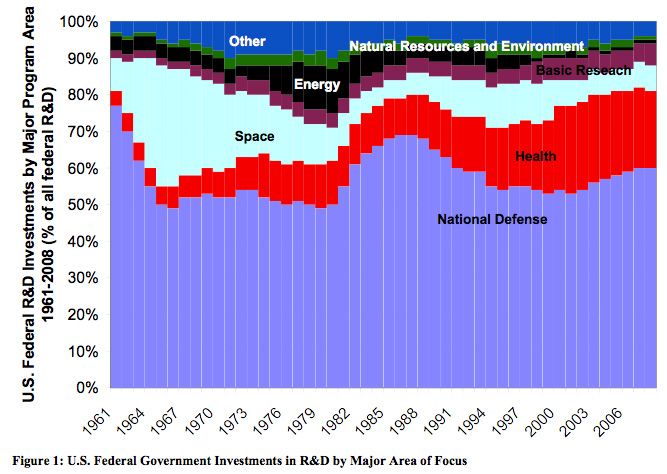The famous French scientist Louis Pasteur once said, “There are no such things as applied sciences, only applications of science.” As a nation we are continuing to find ourselves in increasingly difficult economic times. Our state and federally elected leaders are constantly under pressure to make difficult appropriations decisions at all levels of their budgets. At the federal level, the National Institutes of Health (NIH), our nation’s primary investor of biomedical research funding, is no exception during this economy. A recent New York Times article, The Science of Spending Stimulus Money Wisely, questioned the value of funding basic research at the cost of immediate jobs and dividends. Indeed, a central question regarding the public financing of biomedical research emerges more routinely: How do we strike the right balance between the funding of basic research and the funding of applied research? What is the value of each to scientific development, the pursuit of knowledge, and most importantly, mankind? These question have been debated for generations, largely because there is no right answer. There is no exact formula, or panel of experts that will be able to determine the exact dollar amount which should be spent in each area, nor is there a correct percentage by which the money should be divided between the two areas. The following article postulates that continued funding and public understanding of basic research, the foundation for all applied research, is the smartest long-term investment of all.

So what is basic research and what is applied research? We have colloquially defined basic research as “research done for the sake of knowledge itself over the course of decades” with perhaps no direct or immediate benefit to society. More formally, basic research is driven by a scientist’s curiosity or interest in a scientific question. The main motivation is to expand man’s knowledge , not to create or invent something, with little to no commercial value. Applied research, on the other
hand, is designed to solve practical problems of the modern world, rather than to acquire knowledge for knowledge’s sake. To begin with, it is difficult to state with any degree of certitude that basic research exists at all. While there is certainly an exception to every rule, it is difficult to conjure a single relevant study, experiment or phenomenon which did not rely upon previous discoveries, except for perhaps the Big Bang, but that leads into a whole other discussion. “People cannot foresee the future well enough to predict what’s going to develop from basic research. If we only did applied research, we would still be making better spears,” points out Dr. George Smoot of the Lawrence Berkeley National Laboratory.
The widely held public view is that applied research provides everything from cures to disease to the ability to use a portable music device to listen to digitized music files. However, virtually everything we benefit from today came on the heels of a discovery yesterday, often discovered in a “basic” research laboratory. It would be difficult to find one scientist
who is trying to answer a question or solve a problem merely because they can, without any benefit to society whatsoever. Projects which are funded by the NIH must all be rooted in one common mission, “making important medical discoveries that improve health and save lives.” Does that mean a particular group of scientists is going to develop a new therapy or find a cure right away? No, not necessarily. Does it mean our money is being wasted? It most certainly does not. President John F. Kennedy’s historic 1961 call for a man on the moon by the end of the decade was supplanted by millions in funding, the majority of which was spent on researching and developing ways of getting an American on the Moon. That is, basic research. Two weeks ago, President Obama announced a bold new initiative, Educate to Innovate, geared towards encouraging students to study and consider careers in science, mathematics, engineering and technology.
Now these same people probably think of applied research as “research which will quickly and directly benefit society”, a cure for cancer, a new therapy for nerve regeneration for people suffering from spinal cord damage, or the latest cell phone. Translation: applied research starts with point A, and at the end yields point B. However, that is not always the case in science. Many applied research groups have started with A, hoping to discover B, and ended up discovering a serendipitous, useful C instead. In 1945, Percy LeBaron Spencer, a scientist working for Raytheon Inc., was conducting radar-related research. He chanced upon an interesting side effect of his lab’s research; a chocolate candy bar had melted in the scientist’s pocket while he was next to a magnetron. A magnetron is the device which produces microwaves. He was curious about this effect, and then placed unpopped corn in front of the magnetron and watched the corn pop. As a result of his observations and curiosity, the microwave oven was invented and sold in 1947. The public would call this an example of applied research because the finding, though indirect, lead to a direct and immediate benefit to society. In the late 1980s, Dr. Ian Osterlough, an executive director of research at Pfizer, was part of a team of researchers studying compounds that might expand blood vessels and treat angina. “Like most scientists and clinicians in this field, I chose a career developing drugs in the hope of improving people’s lives,” said Osterlough. “I say ‘hope’, because often pharmaceutical research and development is a source of frustration and disappointment. Certainly, we make a continual contribution to scientific and medical knowledge, but our work doesn’t always yield new medicines. Very few of us get to work on compounds that ultimately benefit patients.” Along his way, something very curious happened. A selective inhibitor, UK-92480, had some very uplifting side effects in volunteers. Thus, Viagra was born!
Which leads into the concepts of science, time and our fast paced society. The public’s perception of science and time are very germane to the discussion at hand. Advancement of science, and in particular technologies such as telecommunications, computers, internet/email, has advanced the pace of our global society, raising people’s expectations about turnaround in communications and deliverables. While these technologies have absolutely increased the rate of scientific discovery from bench to bedside or market, on some level science still moves at a pace slower than the public would like. As a result, there has been a shift from funding basic research to funding more applied research particularly in the biomedical sciences, the belief being if more applied research is funded, a quicker return on our investment will be realized. Unfortunately, science is not a linear business per se; it doesn’t work that way. Surely some things will come to product fruition a bit quicker, but at what cost to basic research and ultimately the future of applied science?

To be quite fair, there is a significant amount of basic research which goes into an applied research project. But if funding for basic research continues to decline, ultimately there won’t be any basic science to apply in the future. Additionally, a greater amount of patience when it comes to scientific progress will be essential. It’s one thing to expect a new cell phone every few months, it’s another issue entirely to expect a new therapeutic compound or disease cure on the same timeline. Dr. David Baltimore, winner of the 1975 Nobel Prize in Physiology or Medicine, from his New York Times article Stifling the Source of the Surplus, said:
Basic research is often considered to be studies done with no practical goal in mind. It may be very abstract. However, years — even decades — after its completion and publication, basic knowledge may suddenly have a great commercial impact. Thus, the health of the American basic science enterprise in the 1950’s and 60’s generated the huge surge of industrial applications in the 70’s, 80’s and 90’s. We have seen this with the fundamental discoveries in microelectronics, biology, information theory, computer science. These basic sciences generated modern telecommunications, biotechnology, the computer industry and now the Internet.
How many people really think along Dr. Baltimore’s lines and how many have the patience to invest and go the distance in hopes of seeing a reward when there are no immediate guarantees? The answer is very few. Basic research is essential for applied research to generate something of benefit for society. If applied research is a pump which supplies water, then basic research is indeed that water which is pumped from the well. This is true in all areas of research, but particularly in the natural sciences, where it may take decades for society to realize the immediate benefits it wants. An excellent example of this would be the disease cystic fibrosis (CF). In the 1950’s, people diagnosed with CF barely lived long enough to attend elementary school. The gene which causes cystic fibrosis was isolated and cloned for observation in 1989. After twenty years of significant iterative biomedical discoveries, people suffering from this chronic disease may live well into their 30’s and 40’s. In the shadow of these giant steps, few, if any, of the over 20,000 papers of peer-reviewed scientific papers on CF would necessarily attract excitement or funding on its own merits. People regularly read the news to learn of a great discovery or product which benefits society. What unfortunately often goes untold is the countless years that went into that great discovery or product.
The great inventor Thomas Edison said “Just because something doesn’t do what you planned it to do doesn’t mean it’s useless.” Not all discoveries are the result of studying A to yield B, sometimes they are the result of an “accident” giving you C. There have been studies where the predicted outcomes would benefit society, yet those outcomes were not necessarily observed. All findings, however, tell us something about the questions being asked. Edison goes on to say, “I have not failed. I’ve just found 10,000 ways that won’t work.” Given the understanding that research does take time to produce benefits to
society, what type of research funding portfolio should society strive for? The answer is highly dependent on the area of study. Some areas may require more time and more money than others. This holds true in industry as well as academia, where the electronics industry often outpaces the pharmaceutical industry with new and innovative products (cost of drug development from basic discovery to market introduction is roughly $500 million per drug). While President Obama’s science and math education initiative is a terrific start, especially in today’s competitive global economy, greater funding of basic and applied research as a significant part of the U.S. federal budget presents an important gateway for innovation, employment, and overall societal benefit through those discoveries. China announced this summer that they will be boosting their research and development budget by a whopping 25.6% from 2008, following the lead of India, which increased its 2007-2008 basic research spending by 21%. A greater understanding of scientific discovery, and in turn a greater amount of patience with the process, by the public and political leaders will be essential to fostering and cultivating a robust scientific culture. Likewise, it is up to scientists and their advocates to promote this understanding through better communication, transparency, and involvement in educational and cultural outreach.
NeuroScribe obtained a B.S. in Biology, and a Ph.D. in Cell Biology with a strong emphasis in Neuroscience. When he’s not busy freelancing for ScriptPhD.com he is out in the field perfecting his photography, reading science policy, and throwing some Frisbee.
~*NeuroScribe*~
*****************
ScriptPhD.com covers science and technology in entertainment, media and pop culture. Follow us on Twitter and our Facebook fan page. Subscribe to free email notifications of new posts on our home page.